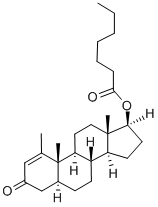Methenolone enanthate efficacy in different diseases
Jul 11,2025
Introduction
Methenolone enanthate (17B-hydroxy-1-methyl-5a-androst-1-en-3-one ester with heptanoic acid, 1-methyl delta-1-androstenolone enanthate) is a synthetic long acting anabolic steroid ester (Fig. 1). In animals there was anabolic activity at least equal to that of testosterone enanthate but very little androgenicity compared to testosterone propionate and testosterone enanthate. In clinical studies methenolone enanthate had more marked anabolic activity than testosterone enanthate and, in the doses employed, masculinization did occur. Liver function tests revealed no hepato-toxic effect.[1]The anabolic-androgenic drug methenolone enanthate has been used in the treatment of advanced breast carcinoma in the postmenopausal women, with no or low hepatotoxic effects. In addition, it has been used by athletes to build the muscle strength. No report on structural biotransformation of methenolone enanthate using microbial cell cultures is found in literature. However, metabolism of its analogue, methenolone acetate was studied in horses [2].

Methenolone Enanthate efficacy in Preventing MRONJ
It is well-known that oral surgical procedures pose a high risk for medication-related osteonecrosis of the jaw in patients taking bisphosphonates. Although some position papers and guidelines have been published with regard to its treatment, few studies have investigated prevention methods. This study investigates the effectiveness of methenolone enanthate, an anabolic steroid, for the prevention of medication-related osteonecrosis of the jaw. Thirty-six Wistar rats were divided into three groups. Two experimental groups, Z and ZM, took zoledronic acid for 6 weeks prior to extraction of the left maxillary first molar. The Group ZM also was given methenolone enanthate continuously for 1 week before and 4 weeks after the extraction. The control group was not given any medication. The rats were euthanized 5 weeks after extraction. The extraction socket was evaluated clinically for bone exposure and histologically for inflammation, hyperemia, collagen fibers, epithelialization, number of osteoclasts, and empty lacunae. Six rats died during the experimental research. The bone exposure rate, mean numbers of attached osteoclasts (in 40× magnification), and empty lacunae (in 100× magnification) were 0%, 4%, and 0.8% in Group C; 75%, 1%, and 8% in Group Z; and 10%, 2.1%, and 3% in Group ZM, respectively. Significant differences exist between all groups regarding the number of empty lacunae. There were significant differences between Group C/ZM and Group Z in terms of bone exposure rate, inflammation, hyperemia, collagen fiber organization, and epithelialization. In this tested preclinical model, methenolone enanthate has shown potential for preventing medication-related osteonecrosis of the jaw.[3]
Methenolone enanthate efficacy in advanced cancer of the breast
Methenolone enanthate was evaluated by a randomized study in the treatment of advanced carcinoma of the breast in postmenopausal women following the protocol established by the Cooperative Breast Cancer Group, Of 27 patients receiving methenolone enanthate,(48%) had objective improvement. There were no improvements in 13 patients receiving testosterone propionate. The median duration of therapy and the median period of survival from the onset of hormone therapy to death or present living time was greater for the responders to methenolone enanthate than the nonresponders. The unusual high incidence of regression from methenolone enanthate therapy may be due to the massive dose employed, a defect in the method of study being employed in clinical trials, a difference that could occur by chance alone or a difference in the biological nature of the disease in the two groups. Since the difference may indicate that methenolene enanthate is an effective hormone, further studies are warranted.[1]
Methenolone enanthate efficacy in aplastic anemia
For the development of an aplastic anaemia a large number of causes is taken into consideration. In this clinical material of 26 patients in 15 patients none of the up to now known noxae could be established. Recently in the clarification of the picture of the disease important pathophysiological realizations were got. In these cases disturbances of the stem cell compartments, effects through the matrix of the haematopoietic cells and immunological processes have been recognized as significant. This investigations concerning the therapy with the anabolic methenolone enanthate yielded approximately the same large number of therapeutic failures and patients with a good result of the treatment or a partial remission in 15 idiopathic and 11 toxically conditioned anaemias. In the partial remissions in most cases a thrombocytopenia continued existing. A therapy lasting at least two months is necessary in order to estimate the result of the therapy. At the present time cannot yet be predicted on which conditions the use of anabolics will be successful.[4]
References
1. Kennedy BJ, Yarbro JW. Effect of methenolone enanthate (NSC-64967) in advanced cancer of the breast. Cancer. 1968;21(2):197-201. doi:10.1002/1097-0142(196802)21:2<197::aid-cncr2820210207>3.0.co;2-r
2. Hussain Z, Dastagir N, Hussain S, et al. Aspergillus niger-mediated biotransformation of methenolone enanthate, and immunomodulatory activity of its transformed products. Steroids. 2016;112:68-73. doi:10.1016/j.steroids.2016.04.007
3. Gürses G, Sur E, Cengiz ZO, Körez MK. Evaluation of Methenolone Enanthate Efficacy in Preventing MRONJ: A Randomized Trial on Rats. J Oral Pathol Med. 2024;53(8):530-537. doi:10.1111/jop.13574
4. Krug K. Beitrag zur Pathophysiologie der aplastischen Anämie und deren Behandlung mit Metenolonenanthat [Pathophysiology of aplastic anemia and its treatment with methenolone enanthate]. Z Gesamte Inn Med. 1980;35(22):809-812.
- Related articles
- Related Qustion
Supplementation with pyridoxal 5'-phosphate monohydrate can synthesize neurotransmitters such as dopamine and serotonin, maintaining a healthy nervous system.....
Nov 4,2025Biochemical EngineeringSubsequently, botulinum toxin was approved for the treatment of numerous disorders of spasticiy and a host of other conditions. Currently it is used in almost every sub-specialty of medicine.....
Jul 14,2025Biochemical EngineeringMethenolone enanthate
303-42-4You may like
Methenolone enanthate manufacturers
- Primo
-

- $5.00 / 1Box
- 2025-11-29
- CAS:303-42-4
- Min. Order: 1Box
- Purity: 99.99%
- Supply Ability: 20000 boxes
- Methenolone Enanthate
-

- $5.00 / 1Box
- 2025-11-29
- CAS:303-42-4
- Min. Order: 1Box
- Purity: 99.99%
- Supply Ability: 20000 boxes
- Methenolone Enanthate(Primobolan)
-

- $5.00 / 1Box
- 2025-11-29
- CAS:303-42-4
- Min. Order: 1Box
- Purity: 99.99%
- Supply Ability: 20000 boxes






